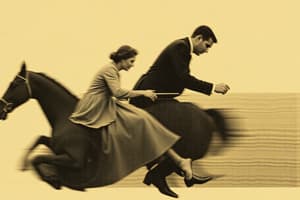Podcast
Questions and Answers
Which equation relates final velocity, initial velocity, acceleration, and time?
Which equation relates final velocity, initial velocity, acceleration, and time?
- $s = ut + \frac{1}{2}at^2$
- $s = vt$
- $v^2 = u^2 + 2as$
- $v = u + at$ (correct)
What quantity describes the total path length traveled by an object?
What quantity describes the total path length traveled by an object?
- Velocity
- Displacement
- Distance (correct)
- Acceleration
In a position-time graph, what does a straight line represent?
In a position-time graph, what does a straight line represent?
- Negative acceleration
- Acceleration
- Non-uniform motion
- Uniform motion (correct)
Which of the following best describes acceleration?
Which of the following best describes acceleration?
What is the significance of the slope in a velocity-time graph?
What is the significance of the slope in a velocity-time graph?
Flashcards are hidden until you start studying
Study Notes
Motion in a Straight Line
Key Concepts
- Displacement: The change in position of an object; a vector quantity that has both magnitude and direction.
- Distance: The total path length traveled by an object; a scalar quantity with only magnitude.
- Speed: The rate at which an object covers distance; calculated as distance/time. It is a scalar quantity.
- Velocity: The rate of change of displacement; a vector quantity defined as displacement/time.
- Acceleration: The rate of change of velocity; can be positive (speeding up) or negative (slowing down).
Equations of Motion (for uniform acceleration)
-
First Equation: ( v = u + at )
- ( v ): final velocity
- ( u ): initial velocity
- ( a ): acceleration
- ( t ): time
-
Second Equation: ( s = ut + \frac{1}{2}at^2 )
- ( s ): displacement
-
Third Equation: ( v^2 = u^2 + 2as )
Types of Motion
- Uniform Motion: Constant speed in a straight line; velocity is constant.
- Non-Uniform Motion: Velocity changes over time; involves acceleration.
Graphical Representation
-
Position-Time Graph:
- Slope represents velocity.
- A straight line indicates uniform motion.
- A curved line indicates acceleration.
-
Velocity-Time Graph:
- Slope represents acceleration.
- Area under the curve represents displacement.
Important Factors
- Frame of Reference: The perspective from which motion is observed, crucial for defining motion (e.g., stationary vs. moving observer).
- Relative Motion: The calculation of the motion of an object with regard to another object.
Applications
- Understanding motion in sports, vehicles, and any scenario involving straight-line travel.
- Fundamental principles in various engineering and physics problems.
Key Units
- Distance/Displacement: meters (m)
- Speed/Velocity: meters per second (m/s)
- Acceleration: meters per second squared (m/s²)
- Time: seconds (s)
Key Concepts of Motion
- Displacement is a vector quantity, highlighting changes in position with both magnitude and direction.
- Distance measures the total path length traveled and is a scalar quantity (only magnitude).
- Speed represents how quickly distance is covered; it is a scalar and calculated as distance divided by time.
- Velocity indicates the change in displacement over time, making it a vector quantity defined as displacement divided by time.
- Acceleration quantifies the rate of velocity change, which can be positive (speeding up) or negative (slowing down).
Equations of Motion (Uniform Acceleration)
- First equation ( v = u + at ): Connects final velocity ( v ), initial velocity ( u ), acceleration ( a ), and time ( t ).
- Second equation ( s = ut + \frac{1}{2}at^2 ): Calculates displacement ( s ) using initial velocity and acceleration.
- Third equation ( v^2 = u^2 + 2as ): Relates the squared velocities and displacement through acceleration.
Types of Motion
- Uniform motion maintains constant speed in a straight line, resulting in constant velocity.
- Non-uniform motion occurs when velocity changes over time, indicating the presence of acceleration.
Graphical Representation
- Position-Time Graph: The slope of the graph represents the object's velocity; a straight line indicates uniform motion, while a curved line shows acceleration.
- Velocity-Time Graph: The slope indicates acceleration; the area under the curve represents the total displacement.
Important Factors
- Frame of Reference: Determines motion observation perspective, essential for accurately defining motion (stationary vs. moving observer).
- Relative Motion: Involves calculating an object's motion concerning another object, important in comparing different velocities.
Applications
- Motion principles have practical applications in sports, vehicle dynamics, and scenarios involving straight-line motion.
- Foundational concepts are critical in diverse engineering and physics problems, underpinning various real-world technologies.
Key Units
- Distance and Displacement are measured in meters (m).
- Speed and Velocity are expressed in meters per second (m/s).
- Acceleration is quantified in meters per second squared (m/s²).
- Time is measured in seconds (s).
Studying That Suits You
Use AI to generate personalized quizzes and flashcards to suit your learning preferences.




